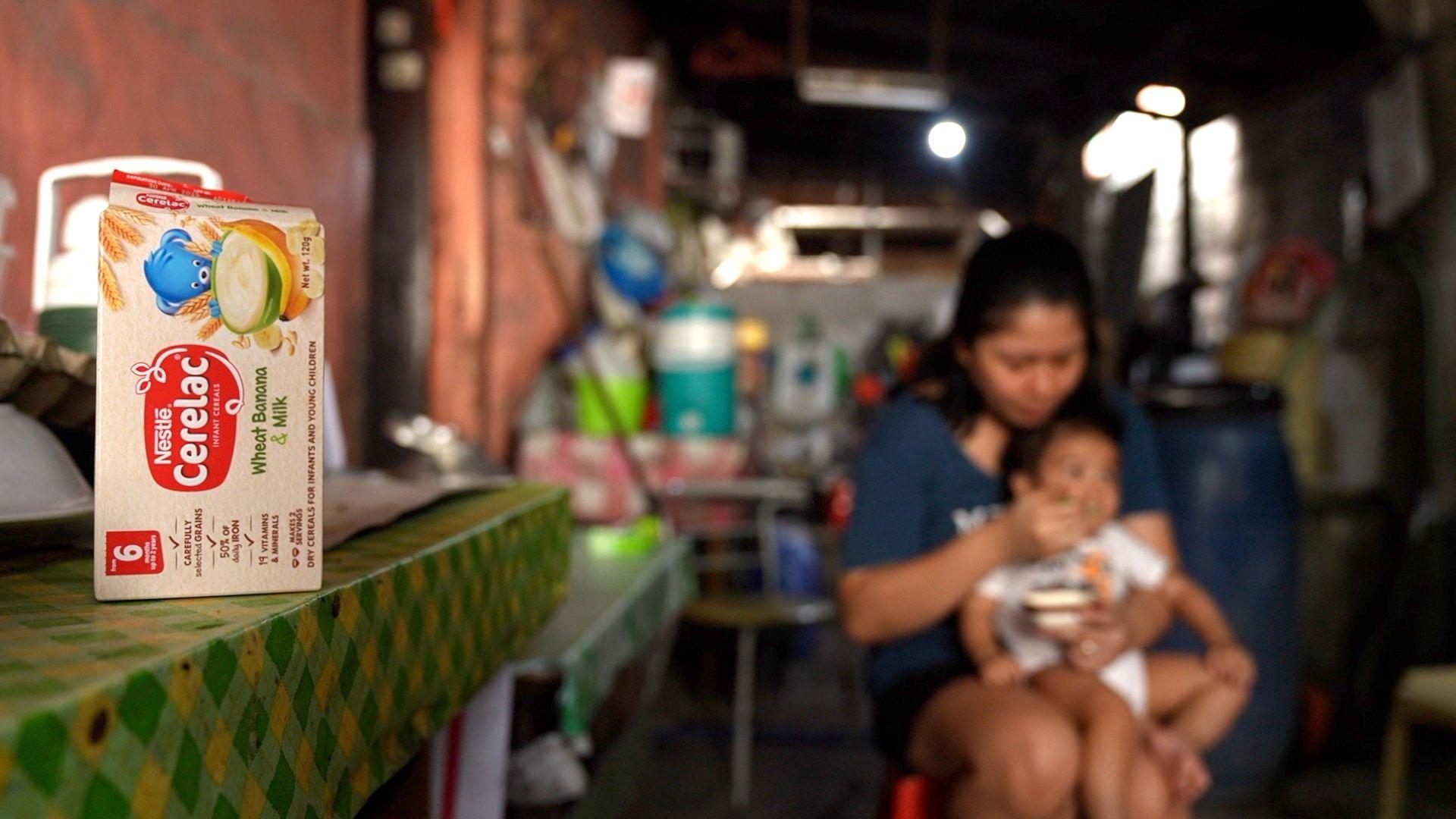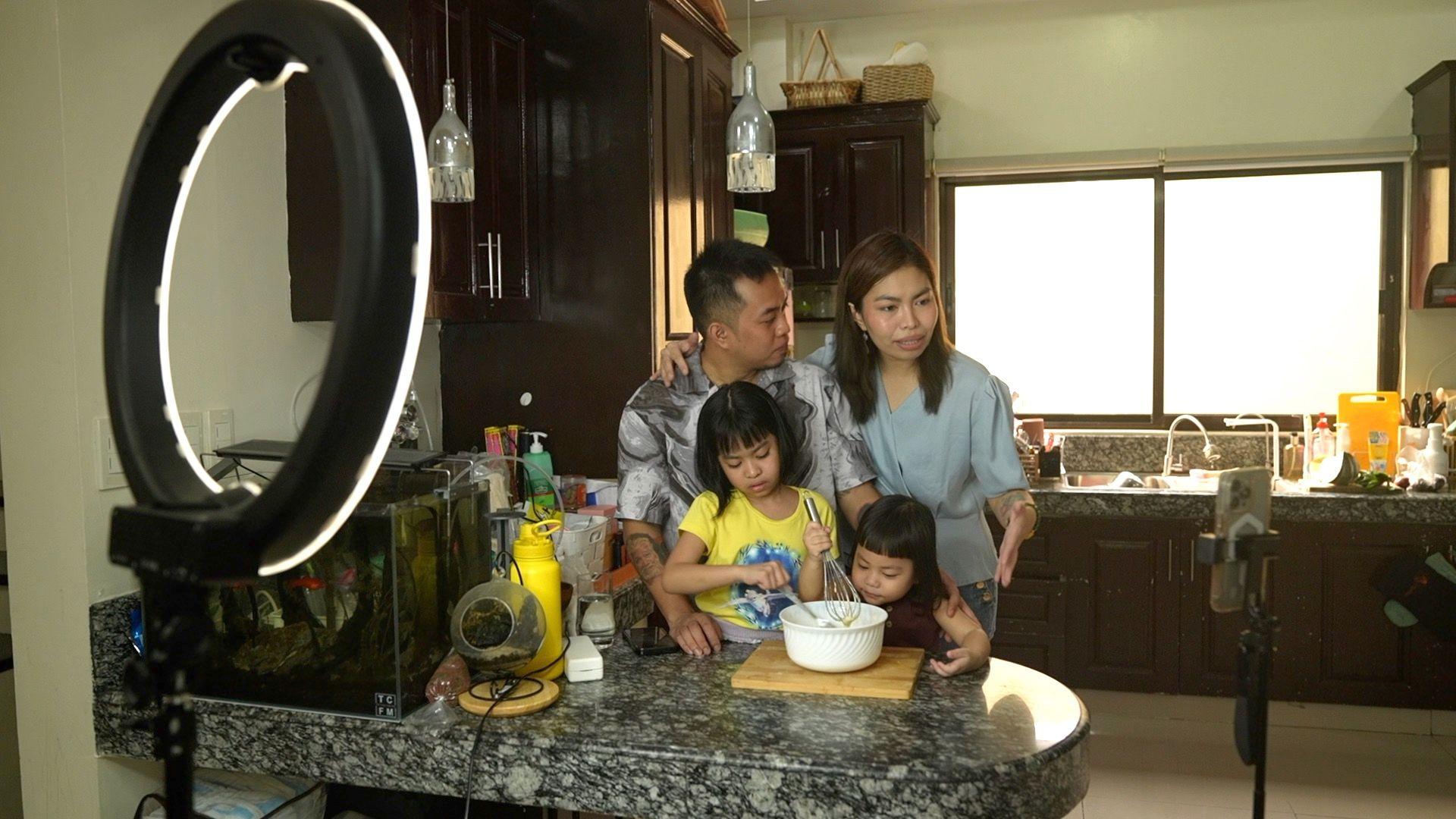Hidden sugars in Asia’s baby food spark concerns

As people get richer in South East Asia, parents are increasingly turning to commercial food products to feed their babies
- Published
Jennylyn M Barrios’ job as a make-up artist takes her all over Manila – precious time away from Uno, her 10-month-old son.
There simply isn’t enough time in the day to make the homemade meals her growing baby needs. But in rapidly developing Philippines, there are increasingly options for busy, working mums like her.
“If I need to make something from scratch, I need to work double time before I finish the product,” she explains.
“But for Cerelac, I just need to add hot water and prepare the mix. I feed it three times a day – for breakfast, lunch, and then for dinner. It’s easy to feed, available, affordable – all great for working mums.”
Jennylyn is one of many mums increasingly turning to commercially available baby food products in recent years: sales of instant cereals, porridges, pureed foods, pouches and snacks across South East Asia have doubled in five years.
Cerelac - an instant porridge mix - is Nestle’s biggest seller here, offering not only convenience but aspiration as well, all for an affordable price, a key consideration with a rise in cost of living.
A quick search on social media shows a slew of aspirational mums with their smiling infants extolling its virtues - including offering some of the crucial nutrients growing children need.
But while the product will be instantly recognisable to parents across the world, the ingredients here may not be.
Because, along with the benefits of added micronutrients Cerelac offers parents in the Philippines and the UK, some flavours in the South East Asian nation offer something else: added sugar.
And that, in a country where parents are increasingly turning from traditional diets to convenience foods, has health professionals worried.

Nestle dominates 98% of the baby food market in the Philippines
In the Philippines, Nestle says it follows a set of standards and guidelines from the Codex Commission – a collective established by the Food and Agriculture Organization (FAO) and World Health Organization (WHO) consisting of food manufacturers, governments and UN agencies.
"The added sugar we have in our products are all well below the threshold prescribed by international and local guidelines who always follow the FDA, who follows Codex, and these are the experts in this field," said Arlene Tan-Bantoto, Nestlé Nutrition business executive officer.
But WHO has called the current standards inadequate and recommends they be updated with a particular focus on avoiding sugar and salt in any food for children under three.
Yet a Unicef study of 1,600 baby foods across South East Asia found nearly half included added sugars and sweeteners.
There is, says Ms Tan-Bantoto, a simple explanation for why it is needed in Cerelac in particular: to disguise the taste of crucial nutrients like iron, which has a metallic taste, and the brain nutrient, DHA, which smells like fish.
“Micronutrient deficiency is widespread in the country and we are serious in our efforts in alleviating it,” said Ms Tan-Bantoto.
“Ninety-seven percent of babies do not meet their daily nutrient requirement, 40% of babies, zero to five, suffer from iron deficiency anaemia. And we know that to be anaemic has lifelong consequences. For instance, brain development and next poor immunity and 20% of kids zero to five are stunted. That means we fortify our products.”
Sugar in first 1,000 days linked to poor health later
- Published31 October 2024
At a clinic in Manila, they see first-hand the impacts of malnutrition on babies and toddlers on a regular basis - although as diets change, so too is how the cases are presenting.
“Sometimes they are underweight, some are overweight, and some are severely malnourished,” one doctor told the BBC.
It is impossible to say exactly why there has been a rise in overweight children. There are multiple factors in the rise of obesity – including a change in lifestyles and urbanisation. But nutritionists say taste preferences are developed at a young age and in some countries like in the Philippines, many foods catering to a sweet palate are started early.
It is why the added sugar in a product like Cerelac is such a concern, according to public health experts like Dr Mianne Silvestre. The most popular flavour of Cerelac in the Philippines has about 17.5g of total sugars per serving – more than four teaspoons of sugar - but that can include both naturally occurring and added sugars. Nestle says in the Philippines, it has several variants or flavours without added sugar, and also flavours with added sugar.
“We always mention that malnutrition isn't just being undernourished, it's also overnourished also overweight and obese children, and very difficult to diet,” explains Dr Silvestre.
“Starting these babies so young on this level of sugar. It’s mind-boggling.”
Unicef nutrition officer for the Philippines, Alice Nkoroi, says a lack of local, government regulation also puts parents at a distinct disadvantage.
“If you go to other countries in Europe... they will have regulations that control what is sold out there and also make sure that companies put out what is they're clear on what is in the content and at the front of the pack, it's easy for the families and consumers to understand what is good for them and what is unhealthy,” she points out.
And it is not just what is in the product - or on the packaging - which needs regulating, she adds. “We conducted a digital scan... and what we saw is that families are bombarded 99% on what is on social media,” Ms Nkoroi said. “There's a need for us to regulate what is coming out or being pushed out there in social media, especially targeted to children.”

Many influencers in the Philippines promote baby food products
Chiara Maganalles - or Mommy Diaries PH as she’s known on social media - has 1.6 million Facebook followers. In a lively YouTube video for Nestle’s “Parenteam” educational platform, she tells tens of thousands of subscribers about the benefits of Cerelac.
She’s been promoting the product for years, and for her, it is a win-win.
“I mean with my first kid... I did feed her Cerelac first because it's convenient... It suits our budget... because of the nutritional content as well, it says that it's fortified with iron,” she said.
Influencing has also transformed Chiara’s life – she’s now able to support her family from the money she makes from brand deals.
But critics say paid partnerships can look like trustworthy expert advice compared to conventional advertising methods. And what Chaira recommended - feeding Cerelac several times a day - goes even against what Nestle told the BBC.
Ms Tan-Bantoto described it as a “complementary” food to a baby’s diet, which should not be taken “the whole day”.
“At least give one bowl,” she said, for the nutritional value.
Nestle says it recommends one serving of infant cereal each day along with a diverse diet of foods, like fruits, vegetables, and meat daily. The company says the information is shared on its product labels, but promotional material on e-commerce sites and its educational platform suggest meal plans with Cerelac products up to three times a day.

Imee Marcos, sister of the current president, is sponsoring a bill that would criminalise added sugar in baby food
The demand for regulation in the Philippines does have some star power. The sister of the current president and daughter of former president Ferdinand Marcos Snr - Imee Marcos - is sponsoring a bill that would prohibit manufacturers of baby food from adding sugar in their products.
A failure to comply could lead to a hefty fine, and imprisonment of producers and manufacturers for one to five years.
“I'm very hopeful that it will see the light of day. There's so many bills and the food lobbies, the huge multinationals that purvey all these foods are immensely powerful and until today I haven't even had a hearing,” Senator Imee Marcos told the BBC.
For its part Nestle says it is listening to concerns, and is phasing out added sugar in baby food - but that balancing the nutritional profile and composition of the product with taste takes time.
The company's bestseller is due to get a sugar-free variety, with plans to completely eliminate all added sugar in the next "two to three years", Ms Tan-Bantoto said.
Research published this week indicates that cutting sugar in the first 1,000 days of a baby's life - from conception to the age of two - appears to reduce the risk of developing significant health issues in adult life.
A team of researchers at the University of Southern California found that limiting the intake of sugar in early life cut the risk of developing type 2 diabetes by 35%, and high blood pressure by 20%.
Experts believe the first 1,000 days of life are a crucial period which can shape a person's future health.
Additional reporting by Ada Tan